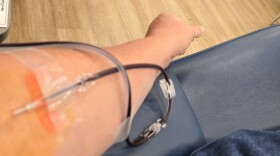-
The world’s supply of many life-saving medications depends on people in the United States deciding to sell their blood plasma. Without them, there would be a global shortage of critical medications and a public health crisis. But what does it take to be a supplier of this indispensable resource? In part 3 of the special series 'Blood Work,' TPR’s David Martin Davies shows us what it’s like to be a compensated plasma donor.
-
The suits accuse the companies of price fixing and kickbacks, which allegedly gave the companies monopolies on certain drugs — resulting in substantially higher prices.
-
The public’s faith in the safety and efficacy of prescription drugs and vaccines has been shaken as never before. There’s skepticism about the role the big pharma plays in rolling out new medications, yet there are amazing breakthroughs in treating once fatal diseases. And then there’s the price for critical treatments that can be beyond the reach for many. How did we get here and how can we fix it? We are joined by Dr Jerry Avorn, professor of medicine at Harvard University Medical School and author of the new book, “Rethinking Medications: Truth, Power and the Drugs you Take.”
-
The country's biggest name-brand pharmacy chains face a high-profile civil trial beginning Monday in Cleveland, Ohio over their role in the nation's deadly opioid epidemic.
-
The DOJ is seeking to block implementation of any part of the Purdue Pharma bankruptcy deal until legal challenges are settled. The deal granted Sackler family members immunity from opioid lawsuits.
-
Creating a brand-new drug is painstaking and tricky — under normal circumstances. In the age of coronavirus, drug researchers are working in overdrive.…
-
The U.S. Food and Drug Administration has approved a new drug to treat a rare blood disorder. It’s the first new treatment for this disease in nearly a…
-
Health insurers are trying to spark a price war by refusing to pay for some brand-name medications unless they get a big discount. This forces some people to change their prescriptions.
-
The big story, the one that made news directors perk up their ears, made congressmen call hearings, and made jaws drop across the country was the story…
-
The deal will create the world's largest pharmaceutical company by sales, bringing together the makers of Viagra and Botox.
Play Live Radio
Next Up:
0:00
0:00
Available On Air Stations










